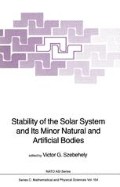Abstract
Integrable hamiltonian systems are interesting because they are quite easy to understand and because many real systems are perturbations of them. When we have a perturbed system it is, in general, no longer integrable. The homoclinic phenomena are responsable for this lack of integrability. This is already seen in suitable perturbations of normal forms near a critical point. However some measure of this lack of integrability is interesting, because it tells us how far is the system of being integrable and, if we allow for some tolerance, we can decide when a non integrable system behaves like an integrable one for practical purposes. The same ideas lead us to a deep understanding of Arnold’s diffusion in systems of more than two degrees of freedom. If we add some dissipative perturbation there is a good chance to find complicated attractors. How and why they appear can be explained in terms of invariant manifolds.
Access this chapter
Tax calculation will be finalised at checkout
Purchases are for personal use only
Preview
Unable to display preview. Download preview PDF.
References
Arnold, V., Avez, A.:Ergodic problems of classical mechanics, Benjamin, 1968.
Churchill, R.C., Rod, D.L.:“Homoclinic and heteroclinic orbits of reversible vectorfields under perturbation”, preprint, 1984.
Delshams, A.;Por gué la difusion de Arnold aparece genericamente en sistemas hamiltonianos de 3 o más grados de libertad, Ph. Thesis, U. of Barcelona, 1983.
Delshams, A., Simó, C.: In preparation.
Duistermaat, J.J.:“Non-integrability of the 1:1:2 resonance”, preprint, 1984.
Font, J.:Variedades invariantes de L 3 en el problema restrigido, M.S.Thesis, U. of Barcelona, 1984 and also this Volume.
Garrido, L., Simó, C.:“Some ideas about strange attractors”, in Proceed.Sitges Conf. on Dynamical Systems and Chaos, Lect.Notes in Phys.179, Springer(1983), 1–28.
Hénon, M. “Numerical study of quadratic area-preserving maps”, Quat.Appl.Math., XXVII(1969), 291–312.
Henon, M., Heiles, C.: “The applicability of the third integral of motion; some numerical experiments”, Astron.J., 69(1964), 73–79.
Jakobson, M.V.:“Absolutely continuous invariant measures for one-parameter families of one-dimensional maps”, Commun.Math.Phys., 81(1981), 39–88.
Llibre, J., Simó, C.:“On the Hénon-Heiles potential”, Actas III Congreso de Ec.Dif.yAplicaciones, Santiago de Compostela(1980), 183–206.
Llibre, J., Simó, C.:“Oscillatory solutions in the planar restricted three-body problem”, Math.Ann., 248(1980), 153–184.
Llibre, J., Martinez, R., Simó, C.:“Transversality of the invariant manifolds associated to the Lyapunov family of P.O. near L2 in the RTBP”, to appear in Journal of Diff.Eg.
Moser, J.; Stable and random motions in dynamical systems, Princeton Univ.Press, Princeton, 1973.
Newhouse, S.:“The abundance of wild hyperbolic sets and non-smooth stable sets for diffeomorphisms”, Pub.Math.I.H.E.S., 50, (1979), 101–152.
Siegel, C.L., Moser, J.:Lectures on Celestial Mechanics, Springer, 1971.
Simó, C.: “Integrability: A difficult analytical problem”, Actas VII Jornadas Mat. Hispano-Lusitanas, Sant Feliu, 1980, 71–80.
Simó, C., Fontich, E.:“On the smallness of the angle between split separatrices”, Proceed.Colloque Géom.Symplect.et Mécanique, Montpellier, 1984, to appear.
Tatger, J.C.:Estudio cualitativo del fenómeno de Newhouse, M.S. Thesis, U. of Barcelona, 1984.
Ziglin, S.L.:“Branching of solutions and nonexistence of first integrals in hamiltonian mechanics, I, II”, Funct.Anal.Appl., 16 (1982), 181–189
Ziglin, S.L.:“Branching of solutions and nonexistence of first integrals in hamiltonian mechanics, I, II”, Funct.Anal.Appl., 17(1983), 6–17.
Author information
Authors and Affiliations
Editor information
Editors and Affiliations
Rights and permissions
Copyright information
© 1985 D. Reidel Publishing Company
About this chapter
Cite this chapter
Simö, C. (1985). Homoclinic Phenomena and Quasi-Integrability. In: Szebehely, V.G. (eds) Stability of the Solar System and Its Minor Natural and Artificial Bodies. NATO ASI Series, vol 154. Springer, Dordrecht. https://doi.org/10.1007/978-94-009-5398-7_23
Download citation
DOI: https://doi.org/10.1007/978-94-009-5398-7_23
Publisher Name: Springer, Dordrecht
Print ISBN: 978-94-010-8883-1
Online ISBN: 978-94-009-5398-7
eBook Packages: Springer Book Archive

